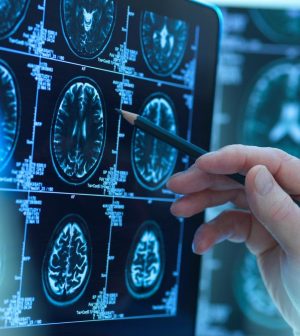- Skip Storing This Everyday Product in the Fridge Door
- Green Tea + B3 Pairing May Boost Brain Health
- Navigating Your Midlife Crisis: Embracing New Possibilities
- City Raccoons Showing Signs of Domestication
- Mapping the Exposome: Science Broadens Focus to Environmental Disease Triggers
- One Week Less on Social Media Linked to Better Mental Health
- Your Brain Changes in Stages as You Age, Study Finds
- Some Suicide Victims Show No Typical Warning Signs, Study Finds
- ByHeart Formula Faces Lawsuits After Babies Sickened With Botulism
- Switch to Vegan Diet Could Cut Your Greenhouse Gas Emissions in Half
Brain’s Wiring May Trigger Depression in Some People

A distinct brain pattern appears to make some people more likely to develop depression, a new study indicates.
“Deep” functional MRI brain scans revealed that a brain feature called the salience network is nearly twice as large in people with depression than in those without the condition, researchers reported Sept. 4 in the journal Nature.
The salience network is a group of brain regions thought to be involved in reward processing and focusing attention, researchers said.
“Having a larger salience network appears to increase the risk for depression—the effect is an order of magnitude larger than what we usually see in fMRI studies,” said senior researcher Dr. Conor Liston, a professor of psychiatry and neuroscience at Weill Cornell Medicine in New York.
Functional MRI scans identify patterns of activity in the brain by measuring changes in blood flow.
Researchers recruited six people with major depression to undergo repeated fMRI brain scans, and compared their results to those from 37 healthy people.
On average, the depression patients had salience networks that occupied 73% more brain surface compared to those of the control group.
The salience network “being implicated in depression kind of makes sense, because one of the main deficits in depression is anhedonia, which is the inability to feel pleasure and enjoy everyday activities,” said lead researcher Dr. Charles Lynch, an assistant professor of neuroscience at Weill Cornell Medicine.
The research team then looked at previous brain scans from hundreds of other patients, to validate what they’d found in this handful of people with depression.
Researchers found that the salience network was more than 70% larger, on average, in 299 patients with depression, compared to 932 healthy controls.
The data suggest that people with larger salience networks in childhood are more likely to develop depression later in life — almost as if they were pre-wired for the condition, researchers said.
“For years, many investigators assumed that brain networks look the same in everybody,” Lynch said. “But the findings in this work build on a growing body of research indicating that there are fundamental differences between individuals.”
The team next plans to study the effects of depression treatments on the activity of brain networks, to see how drugs and other therapies work to quell depressive symptoms.
More information
The National Institute of Mental Health has more about depression.
SOURCE: Weill Cornell Medicine, news release, Sept. 4, 2024
Source: HealthDay
Copyright © 2025 HealthDay. All rights reserved.










